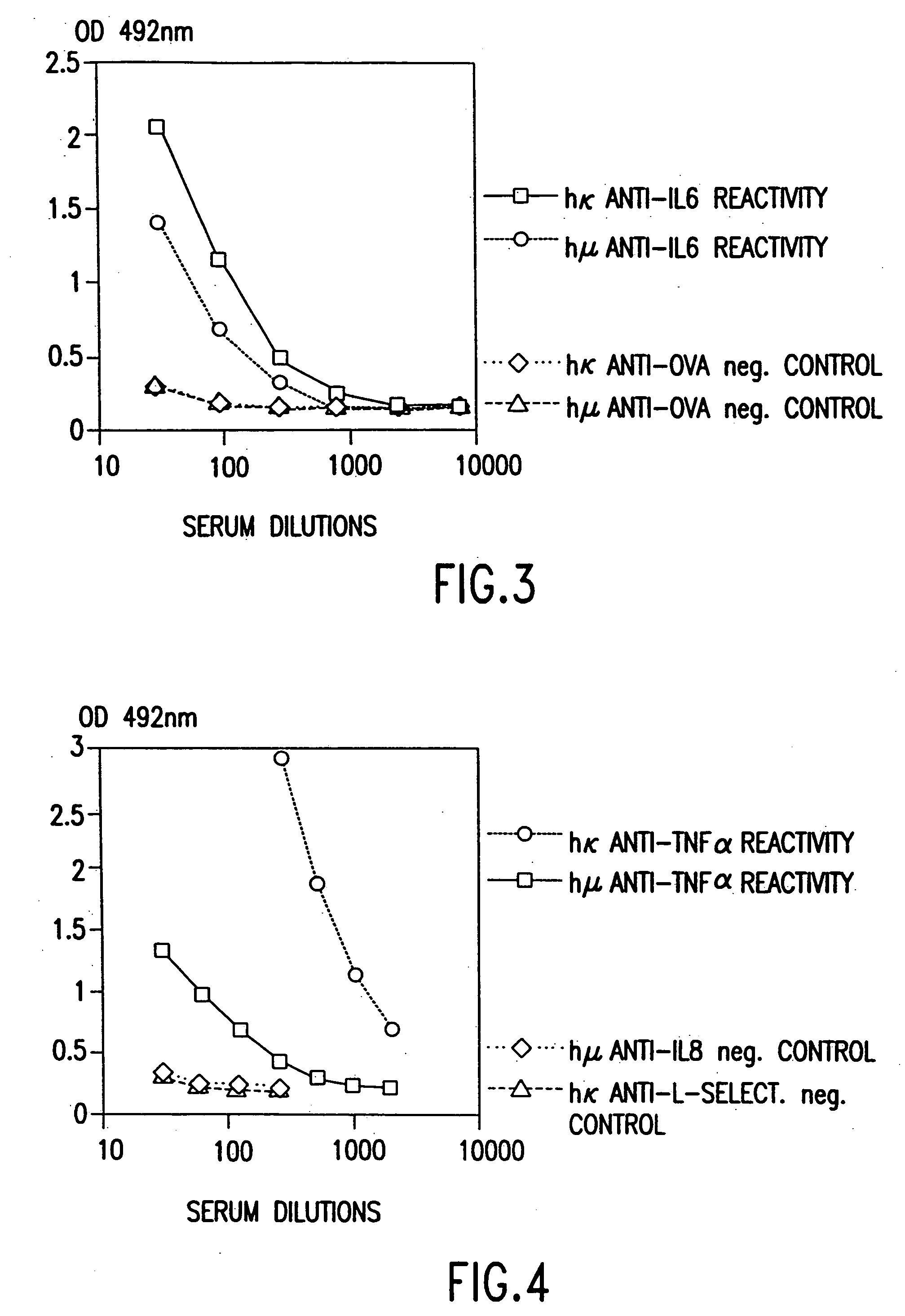Human antibodies derived from immunized xenomice
a technology of human antibodies and xenomice, which is applied in the field of immunology, can solve problems such as problems in the use of human antibodies intended for human therapeutic and in vivo diagnostic purposes, in particular, and achieve the effects of improving the quality of life and reducing the risk of infection
- Summary
- Abstract
- Description
- Claims
- Application Information
AI Technical Summary
Benefits of technology
Problems solved by technology
Method used
Image
Examples
example 1
Human Antibodies Against Human IL-6
[0080] Three to five XenoMouse™ aged 8-20 weeks were age-matched and immunized intraperitoneally with 50 μg human IL-6 emulsified in incomplete Freund's adjuvant for primary immunization and in complete Freund's adjuvant for subsequent injections. The mice received 6 injections 2-3 weeks apart. Serum titers were determined after the second dose and following each dose thereafter. Bleeds were performed from the retrobulbar plexus 6-7 days after injections. The blood was allowed to clot at room temperature for about 2 hours and then incubated at 4° C. for at least 2 hours before separating and collecting the sera.
[0081] ELISAs were conducted as described above by applying 100 μl / well of recombinant human IL-6 at 2 μg / ml in coating buffer. Plates were then incubated at 4° C. overnight or at 37° C. for 2 hours and then washed three times in washing buffer. Addition of 100 μl / well blocking buffer was followed by incubation at room temperature for 2 ho...
example 2
Human Antibodies Against Human TNFα
[0084] Immunization and serum preparation were conducted as described in Example 1 except that human recombinant TNFα (at 5 μg per injection) was substituted for human IL-6. ELISAs were conducted as described in Example 1 except that the initial coating of the ELISA plate employed 100 μl / well recombinant human TNFα at 1 μg / ml in coating buffer.
[0085] The dilution curves for serum from XenoMouse™ after 6 inductions obtained are shown in FIG. 4. Again significant titers of human anti-TNFα binding were shown.
[0086] Serum titers for hγ, hμ, and hκ after one and two immunizations of the XenoMouse™ are shown in Table 1. When challenged with TNF-α, the XenoMouse™ switches isotypes from a predominant IgM response in the first immunization to an immune response with a large IgG component in the second immunization.
TABLE 2Anti TNF-alpha serum titer responses of Xenomouse-2.Bleed 1: after 2 immunizationsBleed 2: after 3 immunizationsELISASerum titersSpeci...
example 3
Human Antibodies Against Human CD4
[0087] The human CD4 antigen was prepared as a surface protein using human CD4ζ on transfected recombinant cells as follows. Human CD4ζ consists of the extracellular domain of CD4, the transmembrane domain of CD4, and the cytoplasmic domain corresponding to residues 31-142, of the mature ζ chain of the CD3 complex. Human CD4 zeta (F15 LTR) as described in Roberts et al., Blood (1994) 84:2878 was introduced into the rat basophil leukemic cell line RBL-2H3, described by Callan, M., et al., Proc Natl Acad Sci USA (1993) 9O:10454 using the Kat high efficiency transduction described by Finer et al., Blood (1994) 83:43. Briefly, RBL-2H3 cells at 106 cells per well were cultured in 750 μl DMEM1−+20% FBS (Gibco) and 16 μg / ml polybrene with an equal volume of proviral supernatant for 2 hours at 37° C., 5% CO2. One ml of medium was removed and 750 μl of infection medium and retroviral supernatant were added to each well and the cultures incubated overnight. ...
PUM
 Login to View More
Login to View More Abstract
Description
Claims
Application Information
 Login to View More
Login to View More - R&D
- Intellectual Property
- Life Sciences
- Materials
- Tech Scout
- Unparalleled Data Quality
- Higher Quality Content
- 60% Fewer Hallucinations
Browse by: Latest US Patents, China's latest patents, Technical Efficacy Thesaurus, Application Domain, Technology Topic, Popular Technical Reports.
© 2025 PatSnap. All rights reserved.Legal|Privacy policy|Modern Slavery Act Transparency Statement|Sitemap|About US| Contact US: help@patsnap.com



